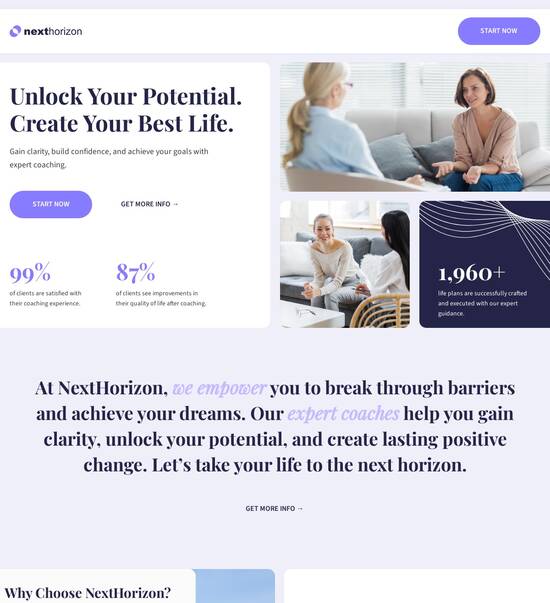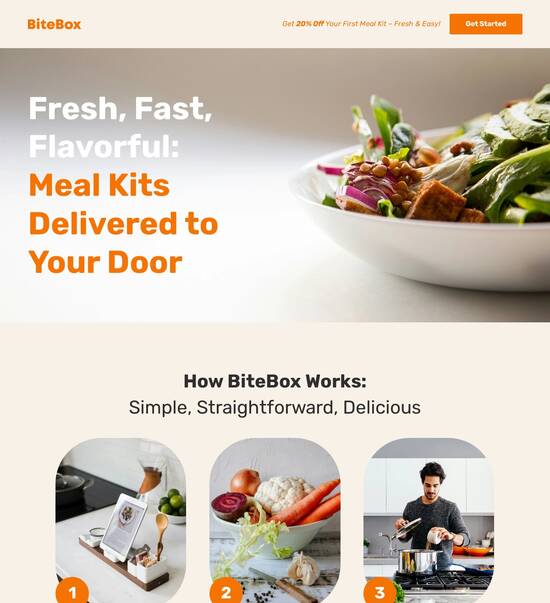
Blog page template for Production engineers
Explore Similar TemplatesAbout template
Master your online marketing with this builder for blog page template for Production engineers. Try more tools to create an immaculate landing page.
Recommended templates

Easy to build without coding
With the intuitive drag-and-drop builder, anyone on your team can create high-converting pages without any knowledge of code or design. Make enhancements to your landing page with custom widgets using Javascript, HTML/CSS, or third-party scripts.

Multiple layouts for any industry and goal
Select from 500+ landing page layouts built to boost conversions across industry-specific scenarios. Customize them by adjusting fonts, adding images, and generating on-brand content with the AI assistant. Quickly scale with Instablocks® and Global Blocks that you can save, reuse, and update globally.

Loads fast and looks polished on any device
Every template is responsive, which means they present professionally on any device and load blazingly fast with our Thor Render Engine. You can also power them up with Google AMP technology to deliver an unparalleled mobile experience and drive higher conversions.

Robust analytics & experimentation
Get real-time updates and reporting across all your devices, showing the number of visitors, conversions, cost-per-visitor, and cost-per-lead. Launch AI-powered experiments, run A/B tests, and use heatmaps to analyze user behavior, then optimize your landing page to maximize conversions.







Easy to build without coding
With the intuitive drag-and-drop builder, anyone on your team can create high-converting pages without any knowledge of code or design. Make enhancements to your landing page with custom widgets using Javascript, HTML/CSS, or third-party scripts.
Multiple layouts for any industry and goal
Select from 500+ landing page layouts built to boost conversions across industry-specific scenarios. Customize them by adjusting fonts, adding images, and generating on-brand content with the AI assistant. Quickly scale with Instablocks® and Global Blocks that you can save, reuse, and update globally.
Loads fast and looks polished on any device
Every template is responsive, which means they present professionally on any device and load blazingly fast with our Thor Render Engine.
Robust analytics & experimentation
Get real-time updates and reporting across all your devices, showing the number of visitors, conversions, cost-per-visitor, and cost-per-lead. Launch AI-powered experiments, run A/B tests, and use heatmaps to analyze user behavior, then optimize your landing page to maximize conversions.
All the features you need to build lead-generating landing pages
Explore more featuresLearn how to build top-performing landing pages for any goal
FAQs
Leading the way in building high-performing landing pages





Your ultimate guide to creating effective landing pages with Instapage
In the fast-paced world of digital marketing, leveraging powerful landing pages is crucial for capturing leads and enhancing conversion rates. Instapage offers a robust platform that enables marketers to create high-performing landing pages effortlessly. This guide will walk you through the steps of using Instapage effectively to optimize your campaigns, ensuring that you maximize ROI.
Understanding landing pages and their importance
Landing pages are essential tools for marketers aiming to convert visitors into leads or customers. Unlike general website pages, landing pages are designed with one specific goal in mind, whether it be generating leads, promoting a product, or driving sign-ups. Utilizing Instapage's library of over 100 high-converting templates can significantly enhance this process by providing proven designs and layouts.
- Targeted messaging: Craft messages tailored specifically to your audience's needs to improve engagement.
- Simplicity in design: Clear, straightforward designs that focus on the call to action will lead to higher conversion rates.
- Integration capabilities: Instapage allows for seamless integration with various marketing tools, enabling uninterrupted campaign flow.
Step 1: Choose the right template
Start by selecting a landing page template from Instapage's extensive collection. The right template can save time and ensure that your landing page adheres to best practices for conversion.
- Identify your target audience: Choose templates that resonate with your specific demographic, whether business services, education, or tech.
- Consider layout effectiveness: Simple, clear layouts lead to better user engagement and lead capture.
- Utilize proven designs: Research which templates have historically performed well in your industry to guide your choice.
Step 2: Optimize your landing page content
Your landing page content should be enticing and clear. Use compelling headlines, engaging visuals, and persuasive calls to action.
- Use dynamic text replacement: Tailor the messaging based on the audience visiting your landing page to increase relevance.
- Implement A/B testing: Utilize Instapage's built-in experimentation features to determine which content resonates best with your audience.
- Incorporate strong CTAs: Every element of the page should guide the visitor towards taking a specific action.
Step 3: Analyze and refine your strategy
To continuously enhance your landing page performance, utilize Instapage's analytics dashboard and heatmaps. These tools will help you understand visitor behavior and identify bottlenecks in your conversion funnel.
- Regularly review performance: Use analytics to track metrics such as visitor conversion rates, bounce rates, and engagement levels.
- Adjust based on insights: Leverage the data obtained from heatmaps to refine page elements and layout for improved performance.
- Stay updated: Keep abreast of the latest trends and best practices in landing pages and CRO strategies.
By employing these strategies, you can optimize your landing pages effectively, driving significant improvements in your conversion rates.
Ready to elevate your digital marketing campaigns? Start using Instapage today to create landing pages that not only attract visitors but convert them into loyal customers.
Blog page template for production engineers
The role of blog page templates in the work of production engineers
Blog page templates serve a crucial function for production engineers as they create a platform for sharing knowledge and experiences in a structured manner. They allow engineers to communicate insights effectively, facilitating collaboration and professional growth. With the right templates, production engineers can efficiently document their processes, analyze challenges, and promote innovative solutions.
Understanding the unique needs of production engineers
Production engineering encompasses the design, operation, and optimization of various production processes. As a discipline that blends engineering principles with manufacturing practices, production engineers must address a range of challenges, including resource management, process efficiency, and quality assurance. These complexities highlight the need for effective communication and documented strategies that can be easily shared with peers and stakeholders.
Challenges faced by production engineers often involve tight deadlines, budget constraints, and ever-evolving technologies. Regularly sharing insights through blog posts can alleviate some of these pressures by fostering a culture of knowledge sharing. Engaging in blogging not only aids in personal development but also contributes to the collective expertise within the engineering community.
Complexities in process optimization
Meeting stringent quality standards
Navigating regulatory compliance
Adapting to technological changes
Significance of blog page templates
Blog page templates provide a framework that simplifies the writing and formatting process for production engineers. These templates ensure that posts follow a consistent structure, which enhances readability and engagement. Templates serve as a guideline, helping engineers to focus on content rather than layout, ultimately allowing more time for thorough research and reflection on key topics relevant to their field.
When templates are utilized effectively, they aid in maintaining a professional tone throughout blog posts. This is essential for building credibility among peers and establishing oneself as a knowledgeable resource within the engineering community. The consistency offered by templates not only improves the appearance of blog posts but also contributes to a stronger personal or organizational brand.
Core features of blog page templates for production engineers
Templates designed for production engineers should integrate user-friendly features that allow for easy customization. When engineers can adjust the layout to fit their unique voice and focus areas, it encourages more authentic content creation. This personalization is critical in making blog posts relatable and engaging for fellow engineers and practitioners.
Additionally, pre-defined layouts that cater specifically to engineering topics can help streamline content creation. Sections should be optimized for technical data, including spaces for charts, formulas, and detailed narratives that discuss complex concepts clearly. Integration of visual aids like images, graphs, and diagrams enhances understanding, and mobile-friendly responsive designs ensure content is accessible from any device.
User-friendly interface for easy customization
Pre-defined layouts for engineering topics
Special sections for technical content, including charts and formulas
Integration with visual aids to improve comprehension
Responsive design for mobile optimization
Leveraging document.addeventlistener for enhanced interactivity
Incorporating interactive elements is vital for engaging blog readers. The **document.addeventlistener** function allows engineers to track user interactions, which provides valuable insights into how readers engage with content. For instance, by monitoring when users click on specific sections, engineers can tailor future posts to maximize content visibility and engagement based on data-driven strategies.
For example, if data reveals a high interest in a specific engineering methodology, future blog posts can focus more intensively on that area, fostering greater reader interest and interaction. This data-driven approach encourages continuous improvement in content strategy. It can also enhance the dynamic of community interaction through comments and discussions around popular topics.
Track clicks on specific sections to understand reader interests
Use interaction data to shape future content strategies
Encourage community engagement through targeted topics
The power of DOMContentLoaded in optimizing page load
The **DOMContentLoaded** event is a critical factor in web development that determines when a web page's HTML has been completely loaded and parsed. For production engineers, ensuring that blog pages render quickly is essential for retaining visitors and providing a seamless user experience. Slow loading times can frustrate users and lead to increased bounce rates, particularly when accessing technical content that requires immediate attention.
To optimize performance, it is essential to utilize **DOMContentLoaded** effectively in blog templates. This can be achieved by minimizing the use of heavy scripts and ensuring that essential styles are loaded beforehand. Engineers should focus on creating streamlined templates that reduce the amount of extraneous code, ensuring that the primary content is available to users as swiftly as possible.
Optimize template structure to prioritize fast content rendering
Minimize heavy scripts for quicker load times
Test page load speeds to enhance user experience
Key benefits of customizing blog page templates for production engineering
Customizing blog page templates allows production engineers to reflect their individual expertise and unique perspectives in their content. Personalization fosters authenticity, which is crucial in building trust with readers and potential collaborators. By consistently presenting their insights and experiences, engineers can cultivate a professional brand that resonates with their target audience.
Additionally, personalized templates can stimulate community engagement among engineers. When readers see content that resonates with their own experiences, they are more likely to comment, share, and engage with the material. This can lead to beneficial collaborations and opportunities for guest contributions from like-minded professionals, enriching the overall community.
Showcase unique expertise and insights
Build a credible and trustworthy online presence
Encourage community interaction and collaboration
Provide a platform for guest contributions and knowledge sharing
Best practices for crafting blog content on production engineering
When crafting blog posts, engineers should focus on identifying relevant topics that address current challenges or trends within the industry. This can involve exploring emerging technologies or discussing recent case studies. A clear understanding of audience interests can guide topic selection, ensuring that content remains engaging and informative.
Structuring posts effectively contributes to clarity and professionalism. A well-constructed blog should contain an introduction, body, and conclusion that cohesively communicate the key message. Important technical data must be cited accurately to maintain credibility, and encouraging discussions through open-ended questions at the end of posts can drive reader engagement.
Identify trending topics and core challenges in production engineering
Structure posts clearly with defined sections
Cite references and technical data for credibility
Encourage comments and discussions to foster engagement
Future trends in blog page templates relevant to production engineers
Emerging technologies in web design are likely to shape the future of blog page templates for production engineers. Responsive designs that adapt to the device being used will become more important, as will the integration of AI to create personalized content experiences. It's anticipated that audience engagement preferences will continue to evolve, with users favoring interactive and visually rich content.
Additionally, incorporating features that allow for real-time updates and feedback can further enhance user interaction. Engineers may also start exploring new communication mediums beyond traditional blogs, such as video content, podcasts, and webinars, to reach wider audiences and enrich the overall learning experience.
Integration of new technologies for better user engagement
Incorporation of AI for personalized content delivery
Adoption of diverse communication channels like videos and podcasts
Case studies: Successful blog implementations by production engineers
Reviewing notable engineering blogs that effectively utilize templates provides valuable lessons for aspiring engineers. For example, several engineers have built robust platforms that focus on niche topics such as sustainable manufacturing techniques or lean production methodologies. Analysis of these blogs reveals that successful implementations often include comprehensive resource sections, engaging visuals, and interactive content.
The key takeaways from these successful cases include the importance of clear focus areas, professional tone, and consistent posting frequency. By adopting these practices, production engineers can establish themselves as thought leaders within their respective fields, fostering community engagement and credibility.
Identify and focus on niche topics to attract targeted readership
Utilize visuals and interactive content to enhance engagement
Maintain a consistent posting schedule to keep audiences engaged
Customizing templates for specific engineering disciplines
When developing blog templates, it's vital to consider the specific needs of various engineering disciplines, such as mechanical, electrical, and industrial engineering. Each specialty has unique content requirements that necessitate customization. For instance, mechanical engineers may require templates that support detailed simulation images and CAD designs, while electrical engineers might benefit from layouts specialized for circuit diagrams.
Furthermore, addressing the diversity of content needs across these different specialties is crucial. Production engineers will find value in templates that allow for innovative presentations of complex material, ensuring clarity and usability. Such customization supports a more thorough exploration of niche-specific topics and helps tailor messages to diverse audiences.
Build templates that cater to specific engineering content needs
Incorporate distinct elements that resonate with each engineering discipline
Empower engineers to present complex ideas simply and effectively
Conclusion: The transformative impact of blog page templates
Blogging has emerged as a powerful tool for production engineers, facilitating the sharing of knowledge and enhancing professional practice. As the engineering field continues to evolve, the importance of well-structured blog page templates cannot be understated. These templates not only streamline the writing process but also amplify the potential for community engagement and knowledge dissemination.
The evolution of digital communication highlights the growing relevance of blogging in technical fields. Customized blog templates will play a significant role in the future, allowing engineers to effectively convey their insights, address ongoing challenges, and ultimately contribute to the growth of the engineering community.
Ready to skyrocket conversions?
Supercharge your ad campaigns with high-performing landing pages
Get started














